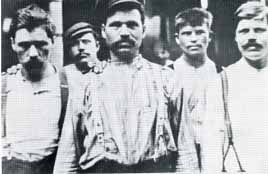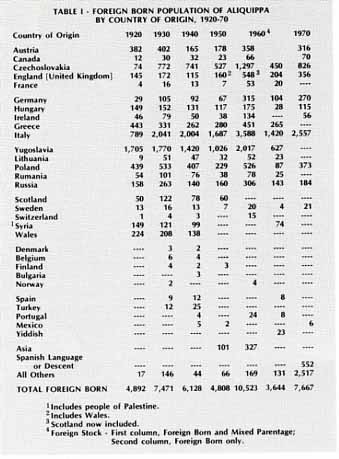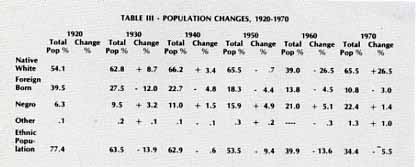
Click Here to Return to Ethnic History Topical Index
Return to Aliquippa History Index
Return to Milestones Vol. 4, No. 2
Shortly after the beginning of the present century, the Jones and Laughlin Steel Company started construction of a huge steel-making plant along the Ohio River in Hopewell Township. Adjacent to the new plant were two communities, the tiny Borough of Aliquippa, site of a popular amusement park on the Pittsburgh and Lake Erie Railroad, and the even smaller village of Woodlawn. In time, the communities were to grow and eventually merge to form the largest borough in Beaver County. But the history of the area in these intervening years was colored by a population factor missing from most of the early communities but common to steel and mining towns - the arrival of many immigrant workers from Southern and Eastern Europe, and of blacks from the impoverished southern states.
The "Aliquippa Works" of J & L bordered Aliquippa Borough (later called West Aliquippa) without changing it drastically, but the pastoral Woodlawn Village was transformed, in a few years, to a huge residential and business complex, housing and serving the needs of more than ten thousand steel workers and their families.
In the two decades following construction of the steel plant, Aliquippa and Woodlawn were rivals for the honors of being the leading steel community. As the towns developed, local officials believed that the lack of political unity hampered solutions to many community problems.- Finally, a plan for consolidation of the two boroughs was discussed. The proposal of a merger was presented to the citizens and approved. Thus, in January of 1928, the merger of Woodlawn and Aliquippa became a reality, the latter becoming the name of both.
Long before the merger of the two Boroughs, ethnic groups already had made their mark upon the area. Aliquippa had been referred to as the textbook example of the "melting pot" theory. This theory is a concept of assimilation through a process of modification of the characteristics of the immigrant to accord with prevalent American types, psychology, customs, and institutions usually by superimposing American manners plus American ideas upon those of the immigrant.
Revisionist historians have challenged this melting pot theory. One such historian, Bayard Rustin, put their position succinctly when he wrote, "there never was a melting pot; there is not now a melting pot; there never will be a melting pot-, and if there were, it would be such a tasteless soup that we would have to go back and start all over."
This revisionist view does not seem to be completely applicable to Aliquippa. The community's ethnic groups have been assimilated into the American cultural ideal, but not at the expense of their heritage. They haven't forgotten their culture and traditions. The people have held fast to their folkways and in many cases have adopted customs, foods, expressions and holidays of other groups. The Serbian and Croatian groups sponsor orchestra and dance groups composed of the adolescent members of their nationalities who perpetuate the use of traditional folk instruments, tunes and dances.
The Orthodox Churches still celebrate Christmas on January 7, complete with traditional foods and customs and music. One of the major ethnic events is the Observance by Italians in Aliquippa of the San Rocco Festival each year in August. While the San Rocco Festival is distinctly Italian in origin, it is celebrated and looked forward to by all residents of Aliquippa. The ethnicity of the area is further illustrated by the annual nationality fair days, first held during the Bicentennial year.
It is tempting to sugarcoat the story of ethnic groups in Aliquippa, but the process of assimilation has been marked by a certain degree of turmoil, hate, violence, and bigotry. There is a complex duality involved in the story of ethnic groups in Aliquippa. Steve Twomey in a recent article, "Education: The Task Was To Make Americans" probably stated it best:
"For the natives of English descent," Twomey writes, "the desire was almost overwhelming to mold the foreigners into the American character.... Yet many .... felt that such mass indoctrination violated the spirit of another great American ideal -- that no one should be forced to accept beliefs....
"Likewise, the immigrants were torn by conflicting forces. Many wanted desperately to become Americans. They knew what ideals America stood for, and had, in fact, come here to partake of those ideals.
"But for many other immigrants the links to the past, to the culture and traditions of the homeland, were equally strong. Often, in fact, these remembrances of another world were all they had to sustain them as they struggled in an alien environment."

Who are these ethnic groups? When did they come? Why did they come? How were they received and treated? Table I provides ethnic groups as they are listed in the United States Census. There are over 30 ethnic groups represented. Table 11 (not included with this web version) give the number and percentage of foreign born for the period from 1920 to 1970, and the number of Blacks in Aliquippa. Table III (not included with this web version) is an attempt to show percentage of groups in relation to the total population as well as percent plus or minus from 1920 to 1970.
The figures in Table I (not included with this web version) shows that the ethnic population and foreign born have long been a significant percentage of the total population of the town. 1930 marks the peak of ethnic population in terms of number of foreign born and those of foreign-born parents or of mixed parentage -- the latter having at least one foreign born parent. 1920, however, marks the peak in ethnic percentage of the total population

The ethnic character of Aliquippa, though generally high, has been steadily decreasing since 1920 as a percentage of the total population. A number of tentative explanations may be given - one is the adoption of restrictive immigration quota laws in the 1920's which discriminated against central, eastern and southern Europeans; another is the improvement of conditions in some European countries by the acquisition of political independence after World War 1; still another is the possible restriction on immigration imposed by some European countries which previously provided the bulk of immigrants to America.
The Negro population of Aliquippa on the other hand has increased steadily both in total number and percentage of the total population. It is particularly interesting to note that while the number of inhabitants in all groups declined between 1960 and 1970 the percentage of the black population in relation to the total population increased.
When did the ethnic and black population begin to come into the area? The published United States Census for 1900 and 1910 does not provide ethnic or racial information for communities of less than 2,500. Both Woodlawn and Aliquippa had a population of 620 in 1900 and 1,743 in 1910. Woodlawn in 1910 had a population of only 1,396.

That there was a significant number of ethnic people in the area by 1907 is attested to by a statement found in the House of Prayer Evangelical Lutheran Church in Aliquippa, Centennial Booklet in which is found the following comment:
"The Logstown Community was now changing (sic 1907). The Jones and Laughlin Steel Company had established their mill, and European immigrants were settling in the area. Most of the members of the House of Prayer had moved to Woodlawn."
Why did immigrants and blacks come to Aliquippa?
Obviously the choice of Aliquippa by Jones and Laughlin Steel Corporation as the site of the new steel works in 1905 had much to do with it. The decade beginning in 1900 saw the influx of over one million immigrants annually into the United States. These immigrants were generally unskilled peasants coming to America in the search for jobs. They found jobs in the heaviest and hardest work in the mills, handling steel billets, loading trains in cinder pits; labor that demanded strength in large measure.
The number of blacks seemed to remain small until after 1910. 1 base this assumption upon two things: first, the first black church, the Emmanual African M.E. Zion Church was not established until 1915. It wasn't at least until then that there were sufficient numbers to-, support a church; second, the outbreak of war in Europe in 1914 cut off immigration to the United States and northern industries turned to the southern black for a new supply of cheap unskilled labor.
What was the reception given to the immigrants and blacks?
David Chaimovitz in his study, "A Public Health Survey of Aliquippa" in 1946 described the housing situation and indicates that blacks were largely confined to Logstown and Plan 11 areas. The discrimination and its affects on the community are described when he wrote'.
"The segregationalism though seemingly inevitable is truly depressing and unfortunate for it fosters misunderstanding and ill-feeling among people who in lieu of the common call which brought them to this country and to Aliquippa should be sympathetic of one another."
The history of the Emmanuel African M.E. Zion Church makes an indirect reference to the existence of racism when it states:
"Burned once, and the congregation was forced to move several times. The Church has had its struggles."
This obviously is an understatement of the difficulties encountered by the blacks.
The immigrant was not received much better by native residents. The following entry appeared in the secretary's book of the House of Prayer Evangelical Lutheran Church of Aliquippa, dated July 18, 1909:
"On account of the foreigners making a picnic ground and gambling resort of the church property yard, and on account of the poor location of the church property, it being amongst the J & L foreigners houses, it was decided to sell the property."
The immigrant and the black both found living conditions which can best be described as dilapidated. Paper was torn off walls, plaster sagging, windows broken, the ceilings low and damp, rooms dark, stuffy and unsanitary, with few openings for either light or air.
The presence of the immigrants, brought an early change to the community during the 1920's: Aliquippa High School began to teach foreign languages other than Latin and French. Also many of the immigrants began to attend Americanization classes in night school at the Jones and Logstown Schools. These classes were established to provide information and assistance to those who wished to qualify for citizenship papers.

The immigrant in Aliquippa while becoming assimilated into American Society continued to cling to his past. The Romanian immigrants, for example, founded the Emenescu Parochial School in Woodlawn. This was one of sixteen such schools in Aliquippa before 1920. The school was established to keep alive among their children Romanian customs, language and culture.
Other groups did similar things. The Serbians first organized a church and school in 1912 and 1913 respectively. In 1914 St. Elijah Serbian Eastern Orthodox Church was founded. Greek and Romanian immigrants organized the Assumption Greek Orthodox Church. Adam Adamakis and other of Greek descent organized a Greek Orthodox Community which received a charter from the Beaver County Courts on January 13, 1919.
Many other ethnic groups and blacks formed similar organizations, many of which are still active today. For example: the Croatian Social Club, Circle of Serbian Sisters, Sons of Italy, Lebanon Society, Slovak American Social Club, N.A.A.C.P. and many others too numerous to mention.
Thrust into an alien culture, living through lean, early years under abominable conditions before improving his lot, the immigrant struggled and finally achieved a measure of success. He was able to combine with his new life the best of the new and the old world cultures demonstrated in the community observance of the San Rocco Festival and the nationality fair days.